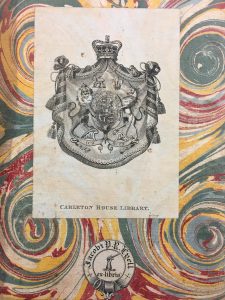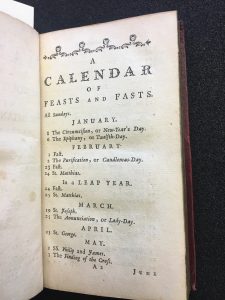This semester, my class and I are embarking on a journey to research and exhibit fore-edge books. These books have secret paintings drawn on the edges of the pages, allowing the viewer to see them if they slant and bend the edges. This past week I have examined some of the Loyola Notre Dame Library’s fore-edge books and have chosen three to research and display. Today, I’ll be focusing on the hidden relationships between the fore-edge and the book itself. Fore-edges are not painted simply to be pretty or to show wealth. Often the paintings are related either to the content of the book or to the life of the owner of the book. Some of these relationships are fairly obvious while others are more discreet. Finding out this relationship for each of my books will be an integral part of research, as it will shed light onto the purpose of these paintings.
The first book I chose was Hurd’s Sermons (Knott_79), which was given to King George IV who at that time was the Prince of Wales. This book has a double fore-edge, meaning that it shows two different pictures when bent forwards and backward. The fore-edges show Pembroke town and its castle and Ripon Minster in Yorkshire. Pembroke is in Wales and thus has a relationship to the Prince of Wales, however, Ripon Minster is in Yorkshire so the connection to the young royal is more ambiguous. Therefore the next step is to keep researching these places, the life of George IV and the book itself.

Knott_79 Hurd’s Sermons. Seal of the Carleton House Library. Published in London by W. Bowyer and J. Nichols in 1776.
My second book contains a similar mystery. The book, Walter Scott’s The Lady of the Lake (Knott_31), has a city scene of Edinburgh’s George Street. However, there is no apparent information of the owner or commissioner of the painting and thus the next step would be to research the street and the book’s contents and search for a connection. George Street was a residential street but now has turned into a major shopping district. The supposed painter of the fore-edge was based in Edinburgh so perhaps there is no specific connection to the book, but rather the artist liked the street.
My third book’s relation to its fore-edge is a bit more apparent, especially if one knows Scottish history or has watched the TV series Outlander. The fore-edge painting is a scene from the Battle of Culloden, which was the last battle of the Jacobite rebellion of 1745 in Scotland (Knott_99). The failure of the battle led to harsh restrictions on Scottish culture by the British government. Most of Scotland and the royal the Jacobites were fighting for, Charles Stuart, were Catholic. The book I am researching is the Manual of Devout Prayer and it is a Catholic manual. This is apparent not only from the archival notes referencing that the book was bound in Rome but also that the book features a calendar of the Feast Days for Saints – a Catholic practice as opposed to a Protestant one. However, what is unclear is why a former Jacobite or a Scot would desire to have a scene from the battle during which they were sorely defeated? Thus for this book I will need to examine why these books were printed in Rome for Jacobite use, Scotland and the Jacobites’ relationship to Catholicism, and the Battle of Culloden in the Scottish mythos.

A Calendar of Feasts and Fast Days, including Saints’ Days from A Manual of Devout Prayer (Knott_99)
Fore-edges are very beautiful to look at but the purpose of these paintings are often more mysterious. Factors such as the book’s topic, the artist, the commissioner, or the intended owner can affect the subject of the paintings. Thus, when doing research, understanding why these paintings exist is a good first step into comprehending more about them. I look forward to learning more about these books and sharing them with you in the upcoming months.
-Amy Swartz
